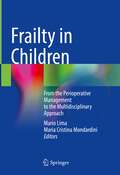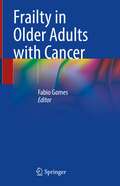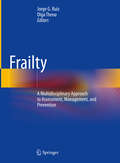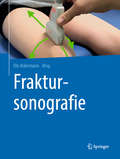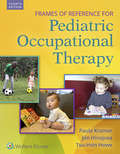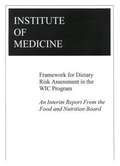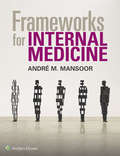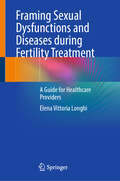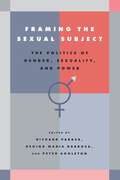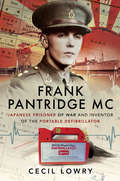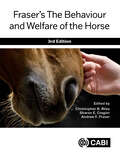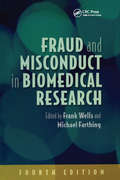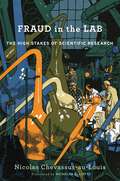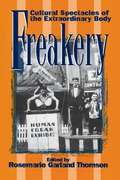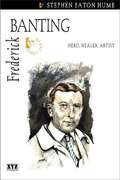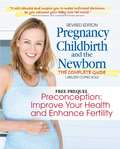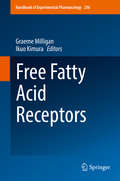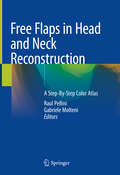- Table View
- List View
Frailty in Children: From the Perioperative Management to the Multidisciplinary Approach
by Mario Lima Maria Cristina MondardiniThis book focuses on the management strategies of complex conditions of frail pediatric patients. The clinical condition of frailty is usually seen as the physiological and multidimensional decline of organ systems related to age: paradoxically, a frailty condition can also occur in children as a disability resulting from various congenital or acquired diseases. The fragile patients are more vulnerable to developing severe clinical events and often need surgical interventions. Moreover, those patients have significant morbidity and lower quality of life. The improvement in managing fragile patients has improved their life expectancy, but in most health care systems, the passage from childhood to adulthood is a critical point for the lack of medical figures able to provide the continuity of care. The book aims to provide guidance for dealing with medical and surgical emergencies and to develop short and long-term treatment strategies, and will provide an analysis of the different and the most innovative techniques. This book will be an unvaluable tool for Pediatric surgeons, Anesthesiologists, Critical Care Physicians, Hospital and family Pediatricians, nurses, Physiotherapists and Psychologists.
Frailty in Older Adults with Cancer
by Fabio GomesThis book summarizes evidence on frailty and ageing, how this may impact patient outcomes and how frailty can be assessed, managed and incorporated in the decision-making process for older patients with cancer. The book aims to: empower clinical teams to assess and support older cancer patients with frailty, ideally within a multidisciplinary setting; and to improve the selection of older cancer patients to the most appropriate management/treatment strategies in order to improve the outcomes of this group of patients often underrepresented in research. The reader will learn the methods available for assessing frailty, such as screening tools, but also how to perform different geriatric assessments covering the different key components (physical, nutritional, social, psychological, etc.). The book also provides information on how to manage and intervene on frailty with the role of pre-habilitation and re-habilitation, how to set-up specialised teams and pathways within one’s hospital and community for these older cancer patients with frailty. Finally, the management of this challenging group of patients according to the cancer type is discussed in detail, alongside with mapping the unmet research needs and future directions in this field.
Frailty: A Multidisciplinary Approach to Assessment, Management, and Prevention
by Jorge G. Ruiz Olga TheouThis book offers a thorough examination of frailty, covering its complexity through sections on foundational concepts, pathogenesis research, assessment methods, management strategies, care settings, its relation to other chronic conditions, and societal implications. It provides a deep understanding of frailty's scientific basis, advanced assessment tools, innovative management, and prevention approaches, and examines frailty within diverse care settings and in relation to other health conditions. By integrating multidisciplinary insights, it presents a holistic view of frailty, addressing its clinical, societal, and policy-related aspects, aiming to enhance well-being and inform clinical practitioners, educators, and policymakers.This book can serve as a reference guide with up-to-date information on frailty in older adults for geriatric medicine physicians, primary care clinicians, geroscience researchers, nurses, therapists (OT, PT, ST), and social workers.
Frakturen der Mittelhand und Finger: Eine Übersicht für Ärzte aller Fachgebiete (essentials)
by Frank Unglaub Adrian Cavalcanti KußmaulFrakturen von Fingern und Mittelhand stellen gemeinsam die häufigsten Frakturen dar. Klinisch kann es neben Schwellungen, Hämatomen und Schmerzen auch zu Funktionseinschränkungen kommen. Die Diagnostik umfasst neben klinischer Untersuchung auch bildgebende Verfahren, insbesondere röntgenologische Untersuchungen. Therapeutisch sollte neben dem Funktionserhalt insbesondere der individuelle Anspruch im Vordergrund stehen.
Fraktursonografie
by Ole AckermannDieses Buch bietet einen Überblick über das Spektrum der diagnostischen Fraktursonografie, die die konventionelle radiologische Bildgebung ergänzen und zum Teil auch ersetzen kann. Vorgestellt werden die apparativen und fachlichen Voraussetzungen, die Indikationen und Abläufe und die möglichen Gefahren. Algorithmen, Pitfalls und Tipps zur rechtssicheren Dokumentation runden die Fraktursonografie in der Praxis ab. Damit bietet das Werk alle relevanten Grundlagen zur Umsetzung in die Praxis.
Frames of Reference for Pediatric Occupational Therapy
by Paula KramerPublisher's Note: Products purchased from 3rd Party sellers are not guaranteed by the Publisher for quality, authenticity, or access to any online entitlements included with the product. Frames of Reference for Pediatric Occupational Therapy, Fourth Edition, uses frames of reference for diagnostic categories (neuro-development, social participation, etc.) as effective blueprints for applying theory to pediatric OT practice. Updated with new chapters, case examples, and a new focus on evidence-based practice. This proven approach helps students understand the “why” of each frame of reference before moving on to the “how” of creating effective treatment programs to help pediatric clients lead richer, fuller lives. The book first covers the foundations of frames reference for pediatric OT (Section I), and then covers commonly used frames of reference such as motor skill acquisition, biomechanical, and sensory integration (Section II). A final section discusses newer focused/specific frames of reference like handwriting skills and social participation. A standardized format within each frame of reference chapter covers the same elements (Theoretical Base, Supporting Evidence, the Function/Dysfunction Continuum, Guide to Evaluation, and Application to Practice) to help students build the knowledge and skills needed for effective practice.
Framework for Dietary Risk Assessment in the WIC Program: Interim Report
by Institute of MedicineThe National Academies Press (NAP)--publisher for the National Academies--publishes more than 200 books a year offering the most authoritative views, definitive information, and groundbreaking recommendations on a wide range of topics in science, engineering, and health. Our books are unique in that they are authored by the nation's leading experts in every scientific field.
Frameworks for Internal Medicine
by Andre MansoorPublisher's Note: Products purchased from 3rd Party sellers are not guaranteed by the Publisher for quality, authenticity, or access to any online entitlements included with the product. Introducing an innovative, systematic approach to understanding differential diagnosis, Frameworks for Internal Medicine helps students learn to think like physicians and master the methodology behind diagnosing the most commonly encountered conditions in internal medicine.
Framing Animals as Epidemic Villains: Histories of Non-Human Disease Vectors (Medicine and Biomedical Sciences in Modern History)
by Christos LynterisThis book takes a historical and anthropological approach to understanding how non-human hosts and vectors of diseases are understood, at a time when emerging infectious diseases are one of the central concerns of global health. The volume critically examines the ways in which animals have come to be framed as ‘epidemic villains’ since the turn of the nineteenth century. Providing epistemological and social histories of non-human epidemic blame, as well as ethnographic perspectives on its recent manifestations, the essays explore this cornerstone of modern epidemiology and public health alongside its continuing importance in today’s world. Covering diverse regions, the book argues that framing animals as spreaders and reservoirs of infectious diseases – from plague to rabies to Ebola – is an integral aspect not only to scientific breakthroughs but also to the ideological and biopolitical apparatus of modern medicine. As the first book to consider the impact of the image of non-human disease hosts and vectors on medicine and public health, it offers a major contribution to our understanding of human-animal interaction under the shadow of global epidemic threat.
Framing Sexual Dysfunctions and Diseases during Fertility Treatment: A Guide for Healthcare Providers
by Elena Vittoria LonghiThis book explores the profound challenges faced by couples embarking on fertility journeys. This transformative experience can often feel demanding and complex, as each person becomes intensely focused on the quest for procreation, potentially losing sight of their own individuality. Alongside this struggle, issues related to sexual function may arise, leading to conflicts within the partnership, mood disorders, and even the development of addictive behaviors such as overeating or engagement with pornography. This book offers comprehensive knowledge and insights for healthcare professionals as they assist couples in navigating this emotionally charged path. It provides invaluable information to help professionals better understand the intricate emotional and psychological dynamics at play, including the impact of sexual dysfunction and strategies for addressing conflicts within the partnership. The ultimate goal of this book is to empower care providers to guide couples along this path with informed and personalized approaches.
Framing the Sexual Subject: The Politics of Gender, Sexuality, and Power
by Richard Parker Peter Aggleton Regina Maria BarbosaThis collection brings together the work of writers from a range of disciplines and cultural traditions to explore the social and political dimensions of sexuality and sexual experience. The contributors reconfigure existing notions of gender and sexuality, linking them to deeper understandings of power, resistance, and emancipation around the globe. They map areas that are currently at the cutting edge of social science writing on sexuality, as well as the complex interface between theory and practice. Framing the Sexual Subject highlights the extent to which populations and communities that once were the object of scientific scrutiny have increasingly demanded the right to speak on their own behalf, as subjects of their own sexualities and agents of their own sexual histories.
Frank Pantridge MC: Japanese Prisoner of War and Inventor of the Portable Defibrillator
by Cecil LowryA biography of the British World War II veteran and Japanese POW camp survivor who went on to create a life-saving device.Countless thousands of men and women around the world have good reason to be thankful that Frank Pantridge survived three and a half years of brutal Japanese captivity. Had he not, they too would in all probability have died too.Taken prisoner at the fall of Singapore in February 1942, Frank was forced to endure appalling deprivation. Conditions on the Burma railway were notorious, and the death rate was horrendous.On returning to Belfast in late 1945, Frank specialized in heart diseases. Convinced that the prompt application of electric shock after cardiac arrest could save lives, he reasoned that ventricular defibrillation should be applied not just in hospitals but in the workplace, the home, the street or ambulance.His first “portable” defibrillator was produced in 1965 and over the intervening years evolved into the compact units so prevalent today. The importance of Pantridge’s invention was well demonstrated when U.S. President Lyndon B. Johnston’s life was saved in 1972.This stirring biography reveals the full story of a remarkable man who survived against the odds to save countless lives.Praise for Frank Pantridge MC“Cecil Lowry's book describes a man who…survived against all the odds. . . . A fascinating and moving story.” —Books Monthly (UK)
Frankincense & Myrrh: Through the Ages, and a complete guide to their use in herbalism and aromatherapy today
by Wanda Sellar Martin WattThe story of frankincense and myrrh runs in tandem with man's evolution. Their use in so many varied ways has accompanied man and woman through the uncertain and often stormy path of life.Once prized as highly as gold, frankincense and myrrh's use in perfumery suggested an exclusivity as do the celebrated perfumes of today. But they offered much more than mere aesthetic delight. At times they were a life-line to spiritual and physical health and well-being.Over many centuries the use of frankincense and myrrh pervaded a wide range of societies and religions. The caravan trails for this valuable cargo have disappeared but these aromatics continue to be valuable commodities both in the East as well as in the West.Frankincense and Myrrh continue to excite the imagination and are probably the most famous aromatics of all time. Their appeal and magic will never die and this book explains why.
Fraser’s The Behaviour and Welfare of the Horse
by Natalie K. Waran Erica K Gee Rebecca Husted Barbara Padalino Gemma Pearson Chris W RogersThis book continues to provide a comprehensive overview of equine behaviour and an outline of current advances in our understanding, as well as offering insights into contemporary and future challenges for improving horse welfare and safety. Completely updated and revised, a new, international, expert editorial team builds on Andrew Fraser's decades of work as an ethologist, veterinarian, historian, horseman, breeder, trainer, conservationist, and field scientist, sharing essential knowledge to improve horse behaviour and welfare. A range of international experts and key opinion leaders have updated this edition to include the effects of noise on the horse's welfare, husbandry and grazing management including the identification of harmful plants and issues of climate change on pasture. New illustrations and examples bring the book to life and further help to explain equine behaviour in a whole range of different situations, including road transport and horse safety during transport. The text covers key issues concerning equipment and the horse's mouth. It gives new insights into genetics, temperament and horse vocalisations and what these indicate. Welfare assessment models are outlined and the challenges presented in different equestrian sports debated. Difficult topics such as euthanasia are also covered. This classic text remains an essential resource for veterinarians, animal scientists, equine professionals and horse owners.
Fraud and Misconduct in Biomedical Research, 4th edition
by Frank Wells Michael FarthingNow in its fourth edition, Fraud and Misconduct in Biomedical Research boasts an impressive list of contributors from around the globe and introduces a new focus for the book, transforming it from a series of monographs into a publication that will quickly become an essential textbook on all areas of research fraud and misconduct.Key features inclu
Fraud in the Lab: The High Stakes of Scientific Research
by Nicolas Chevassus-au-LouisFrom manipulated results and fake data to retouched illustrations and plagiarism, cases of scientific fraud have skyrocketed in the past two decades. In a damning exposé, Nicolas Chevassus-au-Louis details the circumstances enabling the decline in scientific standards and highlights efforts to curtail future misconduct.
Frauen, die Sex verkaufen: Ein Überblick über die psychologische Forschung mit klinischen Implikationen
by Elizabeth Krumrei Mancuso Bennett E. PostlethwaiteAuf der Grundlage führender empirischer psychologischer Forschungsarbeiten aus der ganzen Welt bietet dieses Buch wertvolle Erkenntnisse über Frauen, die Sex verkaufen. Es fasst die umfangreiche wissenschaftliche Arbeit zum Thema Frauen, die Sex verkaufen, aus einer psychologischen Perspektive zusammen, um zu verstehen, warum Frauen sich dafür entscheiden. Im Gegenzug hebt das Buch eine Reihe wichtiger soziokultureller Kontexte rund um den Verkauf von Sex hervor, die große Stressquellen darstellen, und untersucht, wie Frauen mit diesen Umständen umgehen. Das Buch veranschaulicht den facettenreichen Charakter des Verkaufs von Sex und trägt zu Debatten über individuelle und gesellschaftliche Reaktionen auf dieses wichtige gesellschaftspolitische - und zugleich zutiefst persönliche - Thema bei. Das Buch enthält originelles Fallmaterial und zeigt künftige Forschungsrichtungen auf. Es ist eine informative und ansprechende Quelle für Akademiker, Forscher, Studenten und Fachleute auf der ganzen Welt.
Freakery: Cultural Spectacles of the Extraordinary Body
by Rosemarie Garland ThomsonFreakery is as much a comment on modern academia as it is an intriguing exploration of the enduring fascination with the construction and presentation of those who have been coarsely categorized as 'freaks,' 'curiosities', prodigies,' and 'monstrosities.'
Freaks (Short Story)
by Tess GerritsenIn this free Rizzoli & Isles short story from New York Times bestselling author Tess Gerritsen, author of The Silent Girl, a bizarre death comes with a supernatural twist. Homicide cop Jane Rizzoli and medical examiner Maura Isles have seen their fair share of mortal crimes, but the death of Kimberly Rayner may qualify as inhuman in more ways than one. When corpse of the emaciated seventeen-year-old girl is discovered next to an empty coffin in an abandoned church, mysterious bruises around the throat suggest foul play. Caught fleeing the scene is the victim’s closest friend, Lucas Henry, an equally skeletal, pale teenager who claims he’s guilty only of having a taste for blood—a craving he shared with Kimberly. But the victim’s distraught father doesn’t believe in vampires, only vengeance. And now, another life may be at risk unless Rizzoli and Isles can uncover the astonishing truth.
Freaks: A Rizzoli & Isles Short Story
by Tess GerritsenIn this free Rizzoli & Isles short story from New York Times bestselling author Tess Gerritsen, author of The Silent Girl, a bizarre death comes with a supernatural twist. Homicide cop Jane Rizzoli and medical examiner Maura Isles have seen their fair share of mortal crimes, but the death of Kimberly Rayner may qualify as inhuman in more ways than one. When corpse of the emaciated seventeen-year-old girl is discovered next to an empty coffin in an abandoned church, mysterious bruises around the throat suggest foul play. Caught fleeing the scene is the victim's closest friend, Lucas Henry, an equally skeletal, pale teenager who claims he's guilty only of having a taste for blood--a craving he shared with Kimberly. But the victim's distraught father doesn't believe in vampires, only vengeance. And now, another life may be at risk unless Rizzoli and Isles can uncover the astonishing truth. Includes a special preview of Tess Gerritsen's new Rizzoli & Isles novel, The Silent Girl, on sale July 5 And don't miss the season premiere of TNT's hit series Rizzoli & Isles on July 11
Frederick Banting
by Stephen Eaton HumeFrederick Banting was a surgeon and a decorated war hero when he had the idea to develop insulin in 1920, This achievement earned him the 1923 Nobel Prize for medicine, a knighthood, and the gratitude of diabetics around the world.
Free Chapter "Your Birth Plan" from Pregnancy, Childbirth, & the Newborn
by Janet Whalley Penny Simkin Ann KepplerPregnancy, Childbirth, and the Newborn is one of the bestselling and most comprehensive books about pregnancy, childbirth, and newborn care on the market. Now completely updated, expanded, and redesigned, this authoritative book is the "bible" for expectant parents and childbirth educators. Here is a free sample chapter for you! In this chapter, Planning for Birth and Post Partum, you'll learn about: * Birth plans and how to use one to help you explore, clarify, and communicate your preferences for labor and birth * Simple steps for preparing and presenting your birth plan * Ways to plan for the postpartum periodHere is a free sample chapter for you!In this chapter, "Planning for Birth and Post Partum," you'll learn about:* birth plans and how to use one to help you explore, clarify, and communicate your preferences for labor and birth;* simple steps for preparing and presenting your birth plan;* ways to plan for the postpartum period.If you like this sample chapter, look for Pregnancy, Childbirth, and the Newborn. It covers all aspects of childbearing, from conception through early infancy, and tells you what to expect. It offers detailed information, suggestions, and advice to help make pregnancy, childbirth, and new parenthood an enjoyable, healthy experience. It presents the latest research-based information on interventions during childbirth, revised statistics and discussion on cesarean birth, and new advice to help you make informed decisions about your care. It's authoritative, yet easy to use. The information is accessible, well organized, and easy to read. It includes engaging photos, illustrations, and boxed features that highlight important information.
Free Clinics: Local Responses to Health Care Needs
by Virginia M. BrennanFree clinics and student-run clinics are an essential part of America's health care safety net.In community after community, pro bono and student-run health clinics have sprung up over the past 30 years, providing critically needed care to medically underserved populations. Free Clinics is a mosaic formed by accounts of such clinics around the United States. These wide-ranging narratives—from urban to rural, from primary care to behavioral health care—provide examples that will assist other communities seeking to find the model that best fits their needs.The Patient Protection and Affordable Care Act has improved access to health care for many Americans, but millions remain and will remain uninsured or underinsured. Free clinics provide non-emergency care to those in need. Nationwide, professionals can be found offering volunteer services at these clinics. Contributors to this volume—typically people with personal familiarity (as clinicians or area residents) with the clinics they write about—cover a variety of topics, including a review of the literature, data-driven accounts of clinic usage, and ethical guidelines for student-run clinics. They describe the motivations of clinic staff, the day-to-day work of a family nurse practitioner working in clinics and teaching at a university, the challenges and rewards of providing health care for homeless people, and more. Student-run clinics are the topic of the second section: in addition to providing care to a small subset of those in need, student-run clinics are an important venue for training future clinicians and helping the seeds of altruism with which many enter their professions to germinate.Free Clinics will be useful to policymakers, students and faculty in public health and health policy programs, and clinicians and students who are embarking on launching new clinics.
Free Fatty Acid Receptors
by Graeme Milligan Ikuo KimuraThis book highlights the important role free fatty acids (FFA) play as potential drug targets. While FFA have long been considered byproducts of cell metabolism, they are now recognized as ligands that regulate cell and tissue function via G-protein-coupled receptors. At least three receptors have been identified for which FFA appear to be the endogenous ligands.
Free Flaps in Head and Neck Reconstruction: A Step-By-Step Color Atlas
by Gabriele Molteni Raul PelliniThis richly illustrated atlas provides a clear and comprehensive step-by-step description of surgical techniques for raising and setting free flaps from different donor sites, to reconstruct damage to the head and neck caused by cancer and trauma. Adopting a highly practical approach, the book describes the indications and technical aspects of each procedure with sets of in-vivo pictures clearly showing the surgical passages. In addition, it discusses microvascular techniques and explores different soft-tissue, perforator and bone flaps, including novel free tissue flaps, presented for the first time in the head and neck field. This book offers invaluable insights into free-flap harvesting and transferring techniques for both residents and experienced specialists in the field of otolaryngology, head and neck, maxillo-facial and plastic surgery.
